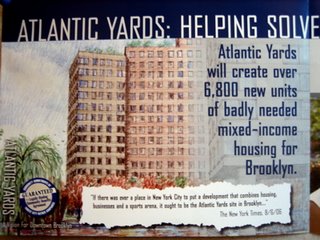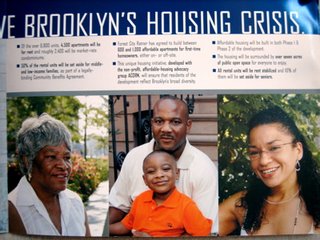With many Brooklynites at risk of homelessness, Atlantic Yards can't help much to "solve Brooklyn's housing crisis"
"58% of all New Yorkers have inadequate savings to pay for expenses like food, housing, and rent in an emergency," declared the Association for Neighborhood & Housing Development (ANHD) in a recent report (chart at bottom), "How is Economic Opportunity Threatened in Your Neighborhood?"
That led to headlines like DNAinfo's Most New Yorkers Are Roughly 1 Paycheck Away From Homelessness: Study and Gothamist's More Than Half Of New Yorkers Are One Paycheck Away From Homelessness, Says Study.
The statistics are compiled by Community District/Community Board. Below are statistics for the four Community Boards in which residents get a preference for 50% of the units in each Atlantic Yards/Pacific Park housing lottery.
First are the statistics for those whose who are at risk of homelessness, then stats indicating the percentage of rent-burdened households:
Managing growth, and the AY angle
Recently, in the New York Post, Nicole Gelinas wrote Elite cities are pushing out the working class:
Gelinas noted that even our infrastructure doesn't support growth any more. (She didn't mention suggestions like adding an F train express, which would stimulate growth in deep Brooklyn, or creating a more regional transit system to support growth in New Jersey.)
What to do?
Gelinas's conclusion:
That led to headlines like DNAinfo's Most New Yorkers Are Roughly 1 Paycheck Away From Homelessness: Study and Gothamist's More Than Half Of New Yorkers Are One Paycheck Away From Homelessness, Says Study.
 |
| 2006 flier from developer Forest City Ratner |
First are the statistics for those whose who are at risk of homelessness, then stats indicating the percentage of rent-burdened households:
- Community Board 2: 51%/37%
- Community Board 3: 67%/54%
- Community Board 6: 48%/35%
- Community Board 8: 63%/50%
Managing growth, and the AY angle
Recently, in the New York Post, Nicole Gelinas wrote Elite cities are pushing out the working class:
Places like New York and San Francisco aren’t dealing with growth very well. “Build more houses” is a rather obvious solution. But people who already live in a neighborhood have a say. They moved to Greenwich Village or the Upper West Side because they liked those neighborhoods, and don’t want them changed by high-rise towers.In other words, the people who get the subsidized Atlantic Yards/Pacific Park apartments, especially the fraction for low-income households, will be very lucky and very happy. There will be a lot more unlucky people still struggling.
And when we build more houses for middle-class and wealthy people in less-expensive neighborhoods, their presence makes that neighborhood more expensive.
One solution is to build subsidized housing. But our best practical efforts yield us 20,000 apartments a year, and the subsidies they require push housing costs up for the people who aren’t lucky enough to win the literal affordable-housing lottery.
Gelinas noted that even our infrastructure doesn't support growth any more. (She didn't mention suggestions like adding an F train express, which would stimulate growth in deep Brooklyn, or creating a more regional transit system to support growth in New Jersey.)
What to do?
Gelinas's conclusion:
One crazy idea: Maybe cities and suburbs that aren’t on the East and West coasts should look to what we do that makes us so expensive, and copy the good parts. That would include neighborhood density, which often means small-scale apartment buildings not far from stores, plus transit, parks and libraries, and low crime.Another idea--ambitious and controversial--comes in the Real Estate Weekly article headlined Chris Ward wants to make Red Hook a model for urban redevelopment:
Aecom’s Southwest Brooklyn vision, which includes Red Hook and the Columbia Waterfront District, covers 246 acres, about eight times the size of Hudson Yards.I recognize the skepticism, but, as REW noted:
...AECOM’s idea for Southwest Brooklyn calls for extending the 1 train to Red Hook and adding two separate stations, adding high-rise development with an interconnected park system, and two new schools, adding affordable housing, streetscape improvement, and an accessible and more resilient waterfront.
The vision calls for up to 45,000 units of housing to be built, to a total of 45 million square feet.
But in a city with a serious housing crisis, more than 50 percent of residents rent-burdened, and a need for more jobs to match the population growth that is expected to add one million new residents in the next 25 years, Ward argued that a vision this grand is necessary.The lesson is that we need much bigger thinking--and, ever unlikely, federal support--to create a more equitable city.
“One of the main things we were focusing on when looking at this and thinking about the fabric of the city, is that no development leads to gentrification,” said Ward.
ANHD 2016 Economic Opportunity Poster by Norman Oder on Scribd

Comments
Post a Comment